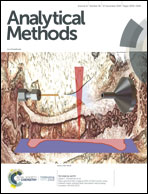A signal-on photoelectrochemical biosensor for detecting cancer marker type IV collagenase by coupling enzyme cleavage with exciton energy transfer biosensing†
Abstract
A signal-on photoelectrochemical (PEC) biosensing platform was developed here for the highly sensitive detection of a cancer marker type IV collagenase, which relied on the exciton energy transfer (EET) between CdTe quantum dots (QDs) and Ag nanoparticles (NPs) combined with the catalytic hydrolysis of a protease. A special sequence peptide chain with positively charged arginines at one end and a cysteine-labeled terminal at the other end, which could be modified with Ag NPs, was designed and synthesized. CdTe QDs and synthetic peptide were assembled onto the surface of indium–tin oxide (ITO) electrodes by means of a layer-by-layer self-assembly technology. The as-obtained modified electrodes generated a lower photocurrent under irradiation due to the effect of EET. The photocurrent intensity increased due to the addition of type IV collagenase, which could specifically hydrolytically cleave Gly–Pro–Ala, leading to Ag NPs being away from the electrode surface. Thus, a signal-on PEC biosensor could be obtained. Under optimum conditions, the PEC biosensor for type IV collagenase exhibited a linear range from 0.5 to 50 μg mL−1 and sensitivity of 96 ng mL−1. The peptide-QD-based PEC detection against type IV collagenase showed a promising potential for other protease or kinase detection when we changed the substrate of the peptide.



 Please wait while we load your content...
Please wait while we load your content...